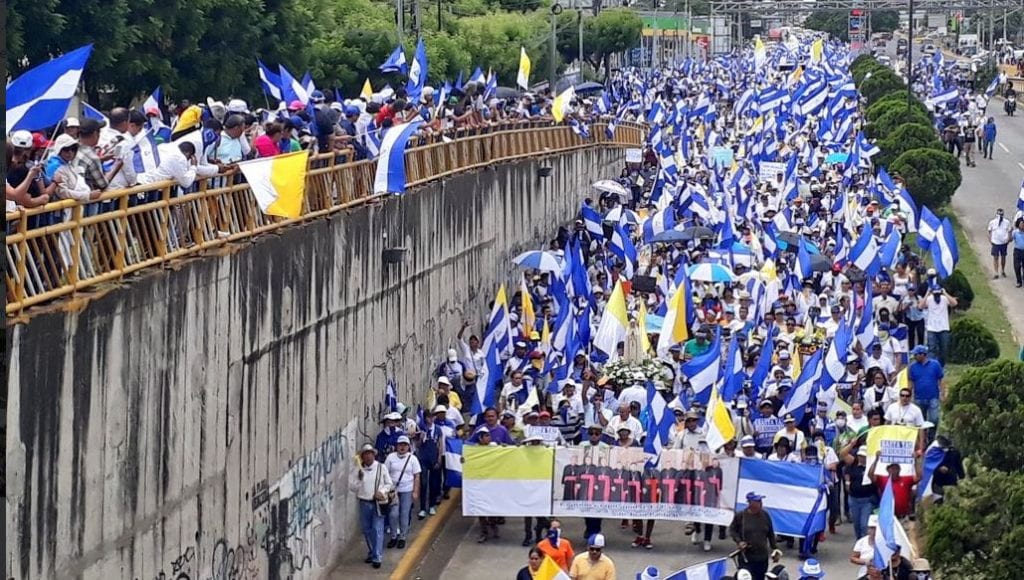Marches Pro and Contra Ortega in Managua without Incident
By Johnny Cajina (dpa)

HAVANA TIMES – Thousands of Catholic parishioners and government opponents took to the streets of the Nicaraguan capital today in support of the bishops who mediate the currently suspended national dialogue and in demand for more justice and democracy in the country. Not far away government officials held a simultaneous counter march in support of President Daniel Ortega.
Waving the flags of Nicaragua and the Vatican, and with posters supporting the bishops of the Catholic Church accused by President Daniel Ortega of being coup-makers and satanic, thousands of people heeded the opposition’s call to participate in a peaceful march that took place along one of the main avenues of Managua.
Meanwhile, government supporters led by police on motorcycles and public employees paraded on another nearby avenue to back Ortega and reject the protests which have taken almost daily since April 18th.
There were no incidents in the marches that took place at the same time.
“Thank you Nicaraguan people for your affection for the Bishops and Priests!”, tweeted Monsignor Silvio Baez, a recognized highly critical voice of the president and the object of harsh attacks by the Government.
Interviewed by the channel 100% Noticias, Monsignor Miguel Mantica also thanked the citizens for their support of the bishops, who in recent weeks have received multiple physical and verbal aggressions by the shock forces of the ruling party, which accuses them of acting in favor of anti-government protesters.
Mantica said the Catholic Church in Nicaragua has been partial not since April 18, when the protests began, but since the sixteenth century, when it advocated for the indigenous during the Conquest and said that, through today, it has been “on the side of those who suffer.”
“Thank you brave bishops for being with your people,” read one of the many banners carried by protesters, including women who carried crosses and yellow and white flags.
Among the participants were the mother and father of a one-year-old baby who was shot in the head a month ago by suspected paramilitaries. The parents demanded justice for the case of the child, whose death is still unpunished.
For his part, retired General Hugo Torres, one of the guerrillas who in 1974 and 1978 led two historic assaults with hostages against the dictatorship of Anastacio Somoza (1967-1979), told dpa that he considers it “unprecedented to start the fight again. against another dictatorship.”
Torres, vice-president of the dissident Sandinista Renovation Movement (MRS), added that “the current situation is worse” because “Ortega is more criminal, he is an updated and augmented version of Somoza.”
The “Pilgrimage for our bishops, defenders of truth and justice”, which was convened by the movement Cry for Nicaragua and the Civic Alliance, began at the “Jean Paul Genie” roundabout to culminate at the Cathedral in the center of the capital.
The protesters, who demanded the resignation of Ortega and his wife and vice-president Rosario Murillo, also called for the release of those arrested in connection with the protests.

Meanwhile, the Government had summoned its supporters and public employees to the southwest of the capital, to participate in a counter-march in which they demanded “justice for the victims of coup-plotting terrorism”, alluding to the police and paramilitaries killed during the protests. [Most of those deaths occurred when they attacked the mostly young people behind self-defense barricades in the different cities and some people defended themselves.]
The government’s march began near the Monserrat neighborhood, where last Monday night a female Brazilian medical student was shot dead by alleged paramilitaries.
According to media reports, the presumed killer of the medical student belonged to the Nicaraguan Army until August 5, 2009 and since then has no relationship with that entity, as confirmed by the Army Public Relations office.
The Police said the killer was a private security guard and used an M4 carbine, a weapon that is not authorized for the country’s security companies.
The crisis in Nicaragua has left at least 448 dead, mostly civilian protestors, and more than 2,800 injured in less than four months, according to independent human rights organizations. The figure is staggering for a country of six million inhabitants. The Government only reports 56 deaths, apparently those of its paramilitary forces and police.





